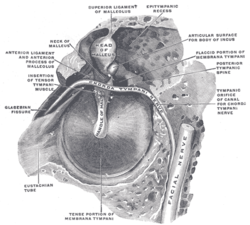Malleus
| Malleus | |
|---|---|
|
Bones and muscles in the tympanic cavity in the middle ear
|
|

Left malleus. A. From behind. B. From within.
|
|

The right membrana tympani with the hammer and the chorda tympani, viewed from within, from behind, and from above. (Malleus visible at center.)
|
|
| Details | |
| Precursor | 1st branchial arch |
| Identifiers | |
| Latin | Malleus |
| MeSH | A09.246.397.247.524 |
| TA | A15.3.02.043 |
| FMA | 52753 |
|
Anatomical terms of bone
[]
|
|
The malleus /ˈmæliəs/ or hammer is a hammer-shaped small bone or ossicle of the middle ear which connects with the incus and is attached to the inner surface of the eardrum. The word is Latin for hammer or mallet. It transmits the sound vibrations from the eardrum to the incus.
The malleus is a bone situated in the middle ear. It is the first of the three ossicles, and attached to the tympanic membrane. The head of the malleus is the large protruding section, which attaches to the incus. The head connects to the neck of malleus, and the bone continues as the handle of malleus, which connects to the tympanic membrane. Between the neck and handle of the malleus, lateral and anterior processes emerge from the bone.
The malleus is unique to mammals, and evolved from a lower jaw bone in basal amniotes called the articular, which still forms part of the jaw joint in reptiles and birds.
Embryologically it is derived from the first pharyngeal arch along with the rest of the bones of mastication, such as the maxilla and mandible.
The malleus is one of three ossicles in the middle ear which transmit sound from the tympanic membrane (ear drum) to the inner ear. The malleus receives vibrations from the tympanic membrane and transmits this to the incus.
...
Wikipedia

